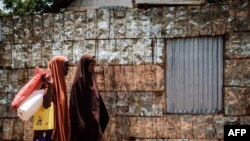This displaced persons camp in Kenya has filled with Somalis fleeing hunger and instability, but now the situation there has taken a new turn with Nairobi banning registration of new arrivals, citing "security issues."
And without paperwork, there's no official aid given.
“They are not recognized by the government. They are not entitled to, for example, to be issued with plots or even other basic services,” said CARE International's John Mwangi.
Halima Omar is one of the Somali returnees locked out of aid programs.
The 47-year-old widow and mother of seven came back to Dadaab after six years back in Somalia. She describes the difficulty of her choice.
“Truth is, life has been hard here. I have to do manual work in the camp, like washing clothes for people to be able to fend for my children. Today, I’m so happy the food I have collected is going to help in a big way,” she said.
Despite the government’s policy change on refugees, aid agencies have helped unregistered refugees like Halima get food aid. They are issued tokens that they cash-in for food.
Guy Avognon is the head of the United Nations High Commissioner for Refugees (UNHCR) in Dadaab. He describes the situation forcing people to come back after trying to make it again back home. .
“There are all those cycles of drought, they are recurring,” he said.
“They happen every nine to 10 years. Usually, they come and stay for a period of three, four years until they’re able to go back when the situation gets better.”
Kenya’s voluntary refugee repatriation program was meant to provide a durable solution to the refugee situation and help ease congestion in the camps.
Kenya began its voluntary refugee repatriation program in 2017, and since then more than 85,000 Somali refugees have resettled back home.
But with the high rate of returning repatriates, experts say players in the sector will have to rethink the strategy.
Officials in Kenya say as the numbers of returnees and new refugees keep rising, aid groups say their services could be stretched further.
Especially because of Somalia's internal discord.
Avognon observed “Let’s hope that this year, people are not going to be crossing the border because of conflict on the other side, so that we can focus and provide support to those who are already here in better conditions until they are able to go back to their countries.”




